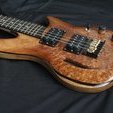Leaderboard
Popular Content
Showing content with the highest reputation on 17/11/18 in all areas
-
Yes - I know. There's nothing wrong with the ranges of good quality but affordable acoustics starting to appear on the scene that are made affordable by dropping the binding. But as you say... Anyway, I chickened out of doing the binding for the back this afternoon and instead rock-hopped back to the neck heel. Still further shaping to do to make it look a little more elegant but I think it will work OK. This shot has also reminded me that the last job after the rest of the binding is finished, is clamping it somehow without crushing it and routing a flaming great big (and very accurate) slot to fit the neck tenon into. Oh joy...1 point
-
And in the meantime I made a bit of progress with the fretboard. Cut a couple of swifts for the 12th fret: Then used a precision router base on the Dremel with a 1.5mm bit: and installed with epoxy mixed with Macassar dust: Dots fixed either side and sanded smooth with the radius block: And that's all up to date as of this morning1 point
-
OK The thing I've done before is using decorative banding to bind the fretboard with. It gives me the advantage of looking like a multi-layer veneer demarcation without the faff and risk of wavy lines of trying to do that: The second thing is something I haven't tried before. Because the neck is from an offcut, it isn't deep enough to give me top of body to bottom in two pieces. And three pieces of maple stacked together could look a bit naff! So I've added a lump of decorative wood. To make it look like it was meant to be there, I've angled it. Won't know until I carve it what it is going to look like, but worth a try!1 point
-
So, pretty much bringing it up to date... Before gluing the top and back on, it's the time to check the fit of things that will be very difficult once the chamber is sealed! Such as where the pre-amp is going to sit: Then, first, the top is glued: The back still has a little to do. The maple cross-grain strips are put on to strengthen the bookmatch join. There is quite a thickness difference in the body between the neck and the tail so I've clamped with a fulcrum strip to help that along while the strips dry: Then the all important label - almost impossible to put it in straight once the back is glued on! The top is now almost final thickness and, being spruce, is susceptible to damage, so I made some ply cauls, chamfered on the bottom edge, to clamp against: And then the back is glued Looks promising: Mind you - having done all that work on the body, the most scary bit is still to do - routing the binding channels and neck mortice slot. Could still end up as BBQ wood, yet!!!! And bringing right up to date with this afternoon, turned my attention to the neck and fretboard. All will be revealed tomorrow:1 point
-
And so to shaping the braces (basically parabola shaped to retain the strength but reduce weight) and tweaking the shape of the braces to get the top to resonate with multiple harmonics at as many of the required frequencies as possible - tap tuning. For anyone interested in this black art (which I only scratch the surface of personally - I know when it's right but I don't know how to get there other than by accident), this is a long but very instructive video. The last 15mins or so has him actually doing the tweaking and by golly you can hear the difference at the end!: https://youtu.be/Ei5-DkVTrEE Mine has ended pretty much where his began (then again, he sells his guitars for many thousands of pounds) but is certainly more resonant that when I started with a number of distinctly different notes, with at least two harmonics, ringing out when various parts of the top is tapped. On this dry fit, you can see that some of the non-structural braces disappear to nothing - and where that happens matters!: The straight brace at the top and the long cross braces are structural and will extend into the kerfed strip, which needs cutting away: As will be seen later - the outside join will actually be cut away! So the glue joint of the kerfed strip itself has to be a good one - but remember, the top and back are curved. So they need sanding at an angle to provide a good gluing surface and tight internal join: While I can see both sides (ie, before the top is glued on), I need to similarly prepare the back. First a purfling strip is set into the join line: That is scraped smooth and then the back braces are put on. The back has a 15 foot radius spheroidal curve so has its own radius dish. The bottoms are radiused to fit the 15' dish in the same way the top braces were radiused to fit the 25' dish: I pre-shape the parabola so use spruce offcut strip to act as the pressure beams for the go-bar struts to press the back into its proper shape in the dish: And then the dry-fit tweaking of the back join is done in the same was the top was: Thread is ALMOST up to date. Next post is gluing the top and back onto the sides which is where I've just got to.1 point


